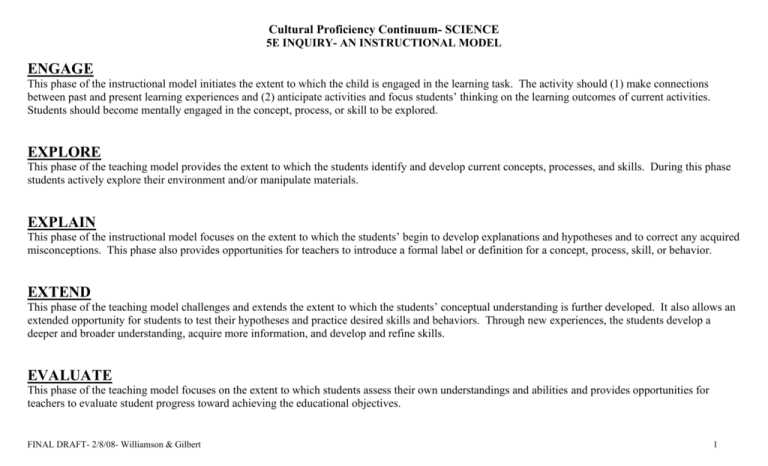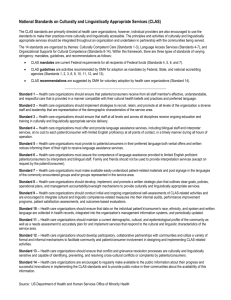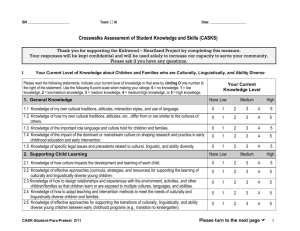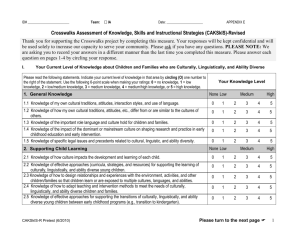Science Cultural Proficiency Continuum
advertisement

Cultural Proficiency Continuum- SCIENCE 5E INQUIRY- AN INSTRUCTIONAL MODEL ENGAGE This phase of the instructional model initiates the extent to which the child is engaged in the learning task. The activity should (1) make connections between past and present learning experiences and (2) anticipate activities and focus students’ thinking on the learning outcomes of current activities. Students should become mentally engaged in the concept, process, or skill to be explored. EXPLORE This phase of the teaching model provides the extent to which the students identify and develop current concepts, processes, and skills. During this phase students actively explore their environment and/or manipulate materials. EXPLAIN This phase of the instructional model focuses on the extent to which the students’ begin to develop explanations and hypotheses and to correct any acquired misconceptions. This phase also provides opportunities for teachers to introduce a formal label or definition for a concept, process, skill, or behavior. EXTEND This phase of the teaching model challenges and extends the extent to which the students’ conceptual understanding is further developed. It also allows an extended opportunity for students to test their hypotheses and practice desired skills and behaviors. Through new experiences, the students develop a deeper and broader understanding, acquire more information, and develop and refine skills. EVALUATE This phase of the teaching model focuses on the extent to which students assess their own understandings and abilities and provides opportunities for teachers to evaluate student progress toward achieving the educational objectives. FINAL DRAFT- 2/8/08- Williamson & Gilbert 1 Cultural Proficiency Continuum- SCIENCE EXPLORE ENGAGE 5 Elements of Effective Science Teaching/ Learning Cultural Destructiveness Cultural Incapacity Cultural Blindness Cultural Pre-Competence Cultural Competence Resists or avoids making cultural or linguistic connections to lessons for diverse student groups, often blaming students for lack of engagement or progress. (e.g. no use of an anticipatory set, requisite vocabulary or knowledge; teacher begins instantaneously with direct instruction on the earthquake unit, leaving some students at a loss.) Limits opportunities for students to make cultural/linguistic connections to lessons, expecting students to do so on their own or believing that doing so compromises the necessary rigor of the lesson. (e.g. teacher asks for information on earthquakes from students and then ignores personal stories and accounts that deviate from the factual information.) Understands the necessity of engaging culturally/linguistically diverse students in new learning but does so inconsistently or uses one-size-fits-all approaches which may or may not meet students’ learning readiness needs. (e.g. teacher identifies geologically active locations throughout the world as an attempt to be culturally sensitive.) Prevent or discourage culturally/linguistically diverse students from working on their own to pose questions/ hypotheses and identify solutions, believing them incapable of doing so. (e.g. independent practice not permitted; all activities are teacher-directed.) Provide limited opportunities for culturally/linguistically diverse students to work on their own to pose questions/hypotheses and identify solutions, often finding fault with their methods or solutions, and supplanting student work with the more desirable teacher-centered outcome. (e.g. teacher occasionally allows students to work independently on activities, but is highly critical with the manner in which students follow procedures and/or respond to constructed response questions.) May use engagement activities regardless of student cultural/ linguistic backgrounds. Does not believe that making cultural/ linguistic connections to lessons has any impact on learning. (e.g. Regardless of student background, knowledge, and experience, teacher uses the single cited engagement activity presented in the adopted text, believing such to be effective for all.) Use textbook identified activities and explorations without making modifications or accommodations, believing them to adequately meet the learning needs of all students. (e.g. teacher selects exploration activities from adopted instructional materials without considering the specific learning needs of students.) Provides regular opportunities to engage students in learning by integrating aspects of students’ cultural backgrounds and experiences into engagement activities and by teaching requisite vocabulary and concepts. (e.g. in a unit on earthquakes, teacher asks questions and solicits information specific to students’ countries and the incidence of earthquakes in those areas.) Consistently uses explorations as a part of lessons to gather important information about diverse students’ strengths and weaknesses and use that information to differentiate instruction that meets students’ diverse learning needs while still ensuring lesson rigor. (e.g. teacher selects an activity from the adopted instructional materials that requires students to locate earthquake activity through a variety of resources and processes.) FINAL DRAFT- 2/8/08- Williamson & Gilbert Recognizing students’ cultural/linguistic differences, the teacher makes modifications to exploration experiments, but may compromise the rigor of the lesson’s outcomes for some students. (e.g. teacher selects an activity from the adopted instructional materials that requires students to conduct an internet search to locate major earthquake activity in the world and substitutes the internet component with a list to choose from because some students have not learned how to navigate the web.) Cultural Proficiency Monitors the extent to which culturally and linguistically relevant scaffolding and anticipatory learning leads to improved outcomes for all students. (e.g. teacher asks or surveys students how the introductory discussion about earthquakes in their countries enhanced their readiness to learn.) Value the processes and outcomes of all students’ explorations, encouraging nontraditional responses and promoting advocacy across the system for student-centered learning and inquiry to enrich engagement and learning especially for diverse student groups. (e.g. teacher allows students to develop their own strategies and identify resources to locate earthquake activity in the world and identify a way to teach it to their peers.) 2 Cultural Proficiency Continuum- SCIENCE EXTEND EXPLAIN 5 Elements of Effective Science Teaching/ Learning Cultural Destructiveness Cultural Incapacity Cultural Blindness Cultural Pre-Competence Cultural Competence Cultural Proficiency Punishes or derides students who do not have prerequisite knowledge and skills. Resists or avoids directly teaching prerequisite vocabulary, concepts, facts or skills believing such to be outside of the responsibility for a teacher of this content or this grade level, thereby impeding some students’ engagement or learning. (e.g. teacher criticizes those students lacking foundational background knowledge taught at lower grade level and ignores their learning needs.) Directly teaches the requisite vocabulary, concepts, processes or skills of a lesson without offering cultural or linguistic bridges for diverse students, thereby impeding student learning. (e.g. teacher frontloads instruction with a review of key vocabulary words, but fails to address word derivations or identify cognates in order to scaffold for academic vocabulary development.) Uses explanation approaches and languages recommended by state educational agencies without seeing a need for supplemental approaches or accommodations to meet the needs of culturally/linguistically diverse students. (e.g. teacher accesses state-recommended pedagogical strategy of “total physical response” (TPR) to demonstrate plate tectonic movement without considering student learning styles.) Directly teaches the requirements of the lesson, sometimes making cultural/linguistic connections that may/may not enhance understanding for all diverse student groups. (e.g. teacher uses multiple pedagogical strategies (TPR, graphic organizers and word walls) to enhance instruction, without considering the specific learning needs of students.) Consistently integrates culturally and linguistically relevant, accurate and appropriate examples and explanations into directly taught lessons; Differentiates instruction to improve learning for underperforming students (e.g. teacher assesses student needs, determines “role playing” and “graphic organizers” to be the most effective strategies for students, and then incorporates these strategies into his/her instruction.) Resist or avoid providing opportunities for lesson extension to underperforming students believing them to be unworthy or incapable. (e.g. teacher provides no extended activities for students, leading to lack of engagement.) Limit opportunities for lesson extension for underperforming students, believing that remediation, reinforcement, drill and practice are more effective ways for underperforming students to master essential learning goals; Uses extension curricula without providing proper scaffolding of the new material or resources to ensure all students’ success, hoping to bring all into the dominant cultural understanding. (e.g. teacher provides additional worksheets to reinforce instruction rather than activities requiring students to apply learned knowledge and/or skills in a new scenario.) Uses traditional, publisher made extension lessons without seeing a need for making modifications or accommodations to meet diverse learning needs. May believe that extended learning opportunities are most applicable for high-performing students, thereby limiting extension opportunities or support for underperforming students. (e.g. teacher provides extended activities only for gifted students.) May differentiate extension opportunities, based on diverse student needs. Some modifications may result in lowered expectations or less rigorous outcomes for some student groups. (e.g. teacher creates a variety of extended activities that vary in their rigor and application.) Consistently provides students with differentiated extension opportunities based on students diverse learning profiles. Differentiated extension opportunities are standardsbased, grade-level aligned, challenging and incorporate inquiry and higher order applications for all students, regardless of diverse learning needs. (e.g. teacher identifies a variety of standards-aligned, grade-level appropriate extended activities for students to choose from to augment learned knowledge and/or skills.) Monitors the effectiveness of instructional modifications and accommodations to improve the learning of underperforming groups and enhance and extend learning for all. (e.g. teacher assesses student needs, determines “role playing” and “graphic organizers” as the most effective strategies, incorporates these strategies into his/her instruction and uses student work and input to determine effectiveness of these strategies; if data indicates students are still struggling with concepts, teacher will provide appropriate intervention or “reteach” concept using a different strategy.) Provides opportunities for students to share learning extensions with each other, reflect on divergent and convergent themes, and identify how individual extensions have contributed to enhanced group understanding of the learning targets and standards for this lesson. (e.g. students research and develop a standards-aligned, grade-level appropriate extended activity to demonstrate their enhanced or extended learnings and are provided class time to share with other students.) FINAL DRAFT- 2/8/08- Williamson & Gilbert 3 Cultural Proficiency Continuum- SCIENCE EVALUATE 5 Elements of Effective Science Teaching/ Learning Cultural Destructiveness Use or misuse assessments and data analysis to promote deficit perspectives about culturally/linguistically diverse students, and to make decisions about placement and instruction that have long term negative educational consequences for them. (e.g. teacher uses a complicated language-dependent test to assess learning of low performing English Learners.) Cultural Incapacity Use assessments without accommodations and resulting data to justify remediation and low-level course work for underperforming diverse students. (e.g. teacher groups students according to achievement data and tracks lower performing students into an instructional program that uses “below standard” instruction.) FINAL DRAFT- 2/8/08- Williamson & Gilbert Cultural Blindness Uses traditional publisher made tests from textbooks believing that they meet the needs of all students and believing that data derived from them fairly evaluate all students’ learning and ability (e.g. teacher uses a publishergenerated multiple-choice test as an end-of-unit summative assessment and makes instructional and placement decisions solely on these test results.) Cultural Pre-Competence Uses and disaggregates student process and product data to modify instruction and accommodate assessments for culturally/linguistically diverse students. Modifications and accommodations may result in lowered expectations and rigor for some student groups. (e.g. after reviewing student assessment data, teacher rewrites test at a lower level rather than re-teaching the lesson based on student needs.) Cultural Competence Cultural Proficiency Uses and disaggregates data from multiple performance measures to identify strengths and needs of underperforming students. Uses this information to develop instruction and formative and summative assessments that support student learning styles, improves learning and provides accurate information about the progress of all students and student groups. (e.g. teacher selects and/or develops multiple measures of assessment based on student learning needs and styles and uses portfolios to track consistent progress towards standards mastery.) Continues to use and disaggregate assessment data to identify learning strengths and needs of all students, to shape instruction and to create an environment where students participate in making decisions about their own learning and ways to demonstrate it. (e.g. teacher solicits student participation in developing authentic assessment and criteria for evaluating learning.) 4




